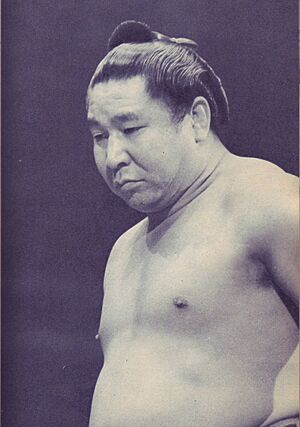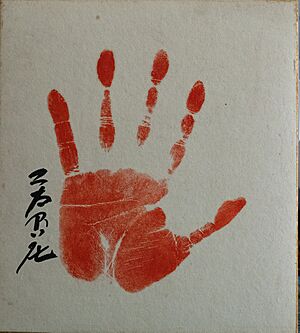Wakanohana Kanji I facts for kids
Quick facts for kids Wakanohana Kanji |
|
|---|---|
| 若乃花 幹士 | |

Wakanohana, 1961
|
|
| Personal information | |
| Born | Hanada Katsuji March 16, 1928 Hirosaki, Aomori Prefecture, Japan |
| Died | September 1, 2010 (aged 82) Tokyo, Japan |
| Height | 1.79 m (5 ft 10+1⁄2 in) |
| Weight | 105 kg (231 lb) |
| Career | |
| Stable | Nishonoseki, Hanakago |
| Record | 593-253-70-4 draws |
| Debut | November, 1946 |
| Highest rank | Yokozuna (January, 1958) |
| Retired | May, 1962 |
| Elder name | Futagoyama |
| Championships | 10 (Makuuchi) 1 (Sandanme) 1 (Jonidan) |
| Special Prizes | Outstanding Performance (2) Fighting Spirit (2) Technique (1) |
| Gold Stars | 6 Haguroyama (2) Chiyonoyama (2) Azumafuji (2) |
| * Up to date as of June 2020. | |
Wakanohana Kanji (Japanese: 若乃花 幹士, Hepburn: Wakanohana Kanji, March 16, 1928 – September 1, 2010) was a Japanese professional sumo wrestler. He was the sport's 45th yokozuna. He was a popular wrestler and was nicknamed the "Devil of the Dohyō" (土俵の鬼, Dohyō no Oni) due to his great fighting spirit and endurance.
Wakanohana's younger brother (by twenty-two years) was the late former ōzeki Takanohana Kenshi and he was the uncle of Wakanohana Masaru and Takanohana Kōji. He won ten top division yūshō or tournament championships during his career and at a fighting weight of around 100 kg was one of the lightest yokozuna ever. He had a long-standing rivalry with Tochinishiki and was one of the most popular wrestlers of the 1950s. After his retirement in 1962 he established Futagoyama stable and was also head of the Japan Sumo Association from 1988 until 1992.
Contents
Career
Born Hanada Katsuji (花田 勝治) in Hirosaki, Aomori Prefecture, he moved to Hokkaidō as a child. After working as a stevedore, he was scouted by the maegashira Onoumi, joining Nishonoseki stable in November 1946. He was trained harshly by Rikidōzan in Nishonoseki stable, and reportedly bit Rikidōzan's leg in retaliation for his training. He began sumo with the shikona or ring name Wakanohana Yoshimi (若ノ花 義美), before changing its given name to his real one in May 1948. Onoumi became head coach of Shibatayama stable after his retirement in May 1952, and Wakanohana followed him to the new stable. It was renamed Hanakago stable in September 1953.
Wakanohana reached the top division in 1950. In September 1955 he fought a bout against yokozuna Chiyonoyama that lasted for over 17 minutes before being declared a draw. In contrast, most sumo matches are over in a few seconds. He was promoted to ōzeki after that tournament. Wakanohana won his first top division championship in May 1956. Shortly before the following tournament his four-year-old eldest son Katsuo was scalded to death when a boiling hot pot of chankonabe fell on him. Despite being devastated by the tragedy, Wakanohana chose to compete in the tournament but ended up dropping out with a fever. He changed the spelling of his ring surname in September 1957, and adopted the given name Kanji in May 1958.
Wakanohana was promoted to yokozuna in January 1958, shortly after he took his second tournament championship. He was the first yokozuna produced by the Nishonoseki ichimon or group of stables in over 20 years and consequently had to borrow the keshō-mawashi of the former Futabayama to perform his first yokozuna dohyō-iri or ring entering ceremony.
Wakanohana's great rival as yokozuna was Tochinishiki. They were very evenly matched, being of similar height and weight, and both ended up with ten top division titles each. In March 1960, they faced each other undefeated on the final day – the first time ever that two yokozuna had met like this. Wakanohana won the match and Tochinishiki retired after the next tournament. Wakanohana kept going until the new era of yokozuna Taihō and Kashiwado, retiring in May 1962.
Wakanohana was such a popular wrestler that he even starred in a feature film about his life, Wakanohana Monogatari Dohyō no Oni made by Nikkatsu and released across Japan on December 27, 1956.
Retirement from sumo
After retirement he set up his own training stable, Futagoyama, which produced a string of top wrestlers, including ōzeki Takanohana (his brother) and Wakashimazu, and yokozuna Wakanohana II and Takanosato. He was also head of the Japan Sumo Association from 1988 to 1992. Among his reforms was an attempt to improve the quality of the tachi-ai or initial charge of a bout by fining wrestlers who engaged in matta, or false starts, beginning in September 1991. In his first year as head of the Association, he also performed his kanreki dohyō-iri or '60th year ring entrance ceremony' to commemorate his years as yokozuna. At the end of his last tournament in charge he presented the Emperor's Cup to his nephew, Takahanada, who had become the youngest ever top division tournament winner. Upon his retirement from the Sumo Association in 1993, his stable merged with his brother's Fujishima stable. He became director of the Sumo Museum. He died of kidney cancer in September 2010 at the age of 82. Umegatani I, who lived to 83, is the only yokozuna to live longer than him.
Fighting style
Wakanohana was a noted technician, and his trademark was his overarm throwing techniques. As well as uwatenage and dashinage he was also well known for yobimodoshi, or pulling body slam, a kimarite that has virtually disappeared from professional sumo today. He was equally adept at both a hidari-yotsu (right hand outside, left hand inside) and migi-yotsu (the reverse) grip on his opponent's mawashi.
Pre-modern top division record
- The New Year tournament began and the Spring tournament returned to Osaka in 1953.
| - | Spring Haru basho, Tokyo |
Summer Natsu basho, Tokyo |
Autumn Aki basho, Tokyo |
|||
|---|---|---|---|---|---|---|
| 1950 | West Maegashira #18 11–4 F |
East Maegashira #9 10–5 |
East Maegashira #4 4–11 |
|||
| 1951 | East Maegashira #7 11–4 F |
East Maegashira #1 8–7 ★ |
East Komusubi #1 7–8 |
|||
| 1952 | West Komusubi #2 5–10 |
West Maegashira #4 5–10 |
West Maegashira #9 10–5 |
|||
| Record given as win-loss-absent Top Division Champion Top Division Runner-up Retired Lower Divisions Sanshō key: F=Fighting spirit; O=Outstanding performance; T=Technique Also shown: ★=Kinboshi(s); P=Playoff(s) |
||||||
| - | New Year Hatsu basho, Tokyo |
Spring Haru basho, Osaka |
Summer Natsu basho, Tokyo |
Autumn Aki basho, Tokyo |
||
|---|---|---|---|---|---|---|
| 1953 | West Maegashira #3 8–7 ★★★ |
East Maegashira #1 8–7 ★ |
East Maegashira #1 8–7 ★ |
West Komusubi #1 8–7 |
||
| 1954 | West Sekiwake #1 8–7 O |
East Sekiwake #1 9–6 |
East Sekiwake #1 9–6 |
West Sekiwake #1 11–4 O |
||
| 1955 | East Sekiwake #1 7–7–1draw |
West Sekiwake #1 10–4–1draw |
West Sekiwake #1 8–7 |
West Sekiwake #1 10–4–1draw T |
||
| 1956 | East Ōzeki #2 13–2 |
East Ōzeki #1 12–3–P |
East Ōzeki #1 12–3–P |
East Ōzeki #1 12–2–1 |
||
| Record given as win-loss-absent Top Division Champion Top Division Runner-up Retired Lower Divisions Sanshō key: F=Fighting spirit; O=Outstanding performance; T=Technique Also shown: ★=Kinboshi(s); P=Playoff(s) |
||||||
Modern top division tournament record
- Since the addition of the Kyushu tournament in 1957 and the Nagoya tournament in 1958, the yearly schedule has remained unchanged.
| Year in sumo | January Hatsu basho, Tokyo |
March Haru basho, Osaka |
May Natsu basho, Tokyo |
July Nagoya basho, Nagoya |
September Aki basho, Tokyo |
November Kyūshū basho, Fukuoka |
|---|---|---|---|---|---|---|
| 1957 | East Ōzeki #1 11–4 |
East Ōzeki #1 10–5 |
East Ōzeki #1 11–4 |
Not held | East Ōzeki #1 11–4 |
East Ōzeki #1 12–3 |
| 1958 | East Ōzeki #1 13–2 |
East Yokozuna #2 12–3 |
West Yokozuna #1 11–4 |
East Yokozuna #2 13–2 |
East Yokozuna #1 14–1 |
East Yokozuna #1 12–2–1draw |
| 1959 | East Yokozuna #1 14–1 |
East Yokozuna #1 12–3 |
East Yokozuna #2 14–1–P |
West #1 11–4 |
West #1 14–1 |
East Yokozuna #1 11–4 |
| 1960 | West Yokozuna #1 0–3–12 |
East Yokozuna #2 15–0 |
East Yokozuna #1 13–2 |
East Yokozuna #1 13–2 |
East Yokozuna #1 13–2 |
East Yokozuna #1 5–4–6 |
| 1961 | West Yokozuna #1 12–3 |
East Yokozuna #1 Sat out due to injury 0–0–15 |
West Yokozuna #1 10–5 |
East Yokozuna #1 3–4–8 |
West Yokozuna #1 10–5 |
East Yokozuna #1 11–4 |
| 1962 | East Yokozuna #2 11–4 |
West Yokozuna #1 0–2–13 |
East Yokozuna #2 Retired 0–0 |
x | x | x |
| Record given as win-loss-absent Top Division Champion Top Division Runner-up Retired Lower Divisions Sanshō key: F=Fighting spirit; O=Outstanding performance; T=Technique Also shown: ★=Kinboshi(s); P=Playoff(s) |
||||||
See also
- Glossary of sumo terms
- Kanreki dohyō-iri
- List of past sumo wrestlers
- List of sumo tournament top division champions
- List of sumo tournament top division runners-up
- List of yokozuna



